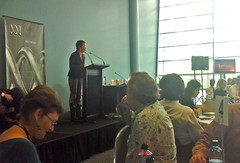 Last Friday I went down to Sydney to attend and speak at the ABC Digital Media Forum, an internal conference exploring innovative possibilities for the national broadcaster especially in the user-led online environment. The ABC is doing pretty well in this field already, and from what I saw at the conference, there are plenty more exciting projects in the pipeline - some of these remain firmly under wraps before they're officially launched, though, so I won't mention them here.
Last Friday I went down to Sydney to attend and speak at the ABC Digital Media Forum, an internal conference exploring innovative possibilities for the national broadcaster especially in the user-led online environment. The ABC is doing pretty well in this field already, and from what I saw at the conference, there are plenty more exciting projects in the pipeline - some of these remain firmly under wraps before they're officially launched, though, so I won't mention them here.
My own contribution was to a session exploring the potential of embedding produsage-based models within the ABC framework, and I've already posted my suggestions here and over at Produsage.org; we had a very constructive discussion afterwards which especially also touched on the institutional requirements of the ABC as a taxpayer-funded, public service media organisation with certain obligations to citizens and government, and I think the immediate future for the organisation probably lies in a tiered approach which quarantines its premium, journalistic content to some extent from the potentially more unruly, raw material generated by users, but also explores possible ways in which the two can constructively connect with one another.
So, in the context of journalism (and of course that's just a part of all ABC operations, if an important one), this could work through an intermediate, 'rough' stage which combines first-take, as yet unpolished news reports from staff journalists with the best commentary, opinion, and citizen journalism that comes through as user-generated content. This pro/am approach would have greater immediacy and breadth of coverage than the premium news while maintain better production values and topical focus than the raw content; the model wouldn't be entirely unlike OhmyNews, for example. Something along these lines would be my suggestion, anyway...
Assuming that such models are interesting for the organisation in the first place, there is a broader question about how successfully to facilitate a culture of innovation in the overall organisation, of course (and indeed, in any large organisation, in the media industry or elsewhere). Keynote speaker Mark Dodgson from UQ's Technology and Innovation Management Centre provided a number of very useful pointers here: he noted that an innovative organisation will
- have a CEO who supports innovation,
- have an explicit innovation strategy,
- understand the value of innovation for its users,
- understand the use of technology internal and external connections (enabling internal and external team interaction & knowledge flow),
- select and support innovation project champions from within the workforce,
- manage risk portfolios,
- have supportive formal and informal organisational processes,
- collaborate with right people and organisations,
- provide incentives for innovation (especially of course the actual implementation of ideas),
- balance the protection of its intellectual property with an openness for new ideas and collaborations,
- tolerate failure (and where possible encourage quick and cheap failure),
- have an internal culture that supports creativity, playfulness and fun (because innovation is thinking, playing and doing), and
- innovate with its users.
Obviously this last point is particularly central to my own research, and Mark pointed to a few useful examples where this has been successful in an institutional context - for example, the BBC's Backstage project which allows users to generate new content by building on and remixing existing BBC materials, or Propellerhead's composition toolkit. He also mentioned Procter & Gamble's move from in-house R&D to an open innovation model they call C&D (connect & develop), where 50% of new ideas come from external sources, and he pointed to 'innovation brokers' like NineSigma, InnoCentive, and Yet2.com, which style themselves as 'eBays for ideas', connecting innovators and financiers.
The rest of the day was taken up by presentations from key ABC staff on current and upcoming projects and on audience trends. Most of this is intended for internal ears only, of course, but I was pleasantly surprised to hear so many current buzzwords used even by senior staff - from multiplatform delivery to hyperlocal content, from Generation C to crowdsourcing, and even to semacode. Clearly, the ABC is seriously on the move into these areas... In-house audience researchers appeared to be particularly on the ball here - they made it very clear that the modern ABC audience increasingly wants choice (in terms of content diversity, and access options), participation, and control, and that the key trends to be served by ABC content must therefore be participation, immersion, and convenience. Indeed, some of this is already coming through strongly in audience data: during 2007, ABC users downloaded some 17 million vodcasts alone (of these, 10 million were vodcasts of Chaser shows, and the APEC security stunt alone was downloaded 900,000 times).
This means that some of the current projects addressing audiences as active users (and beyond that as collaborative content produsers) are now particularly important as first test cases for new media models at the ABC. Such projects include for example the ABC Now rich media player - which deserves more attention than it's received so far - and the Pool project for user-led content creation which is now in its beta release. (Pool is precisely the sort of 'raw tier' project I mentioned above.) I think we'll see this revised understanding of ABC audiences slowly spread across many more parts of the ABC's operations - especially once some of the other projects currently under development see the light of day...
An exciting day overall - many thanks again to Tony Walker for inviting me along.












